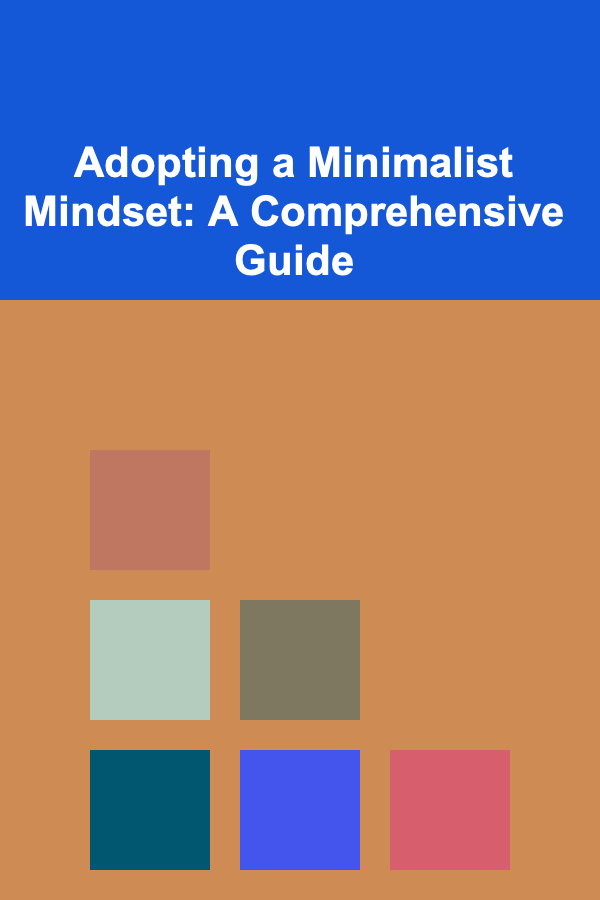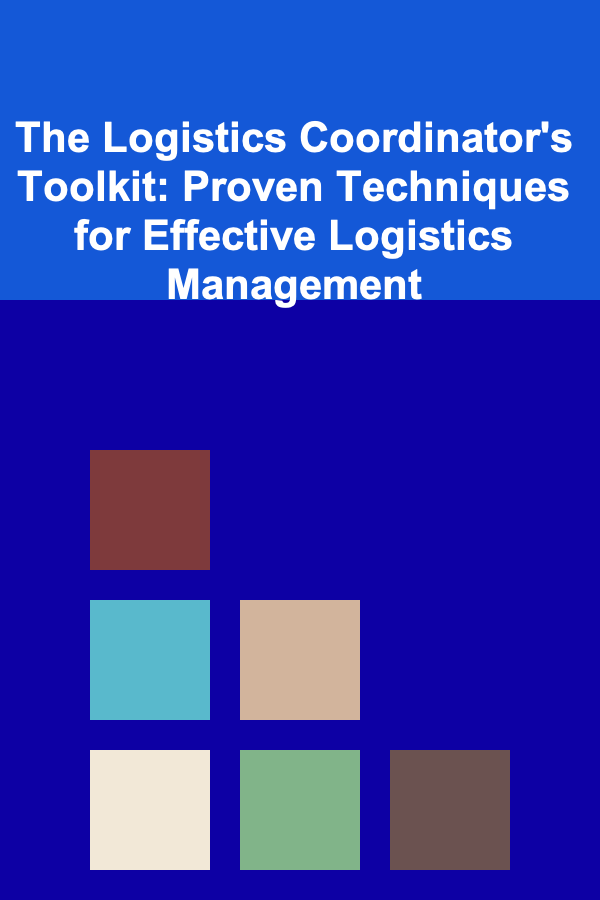
Adopting a Minimalist Mindset: A Comprehensive Guide
ebook include PDF & Audio bundle (Micro Guide)
$12.99$7.99
Limited Time Offer! Order within the next:

In an increasingly consumer-driven world, the concept of minimalism has gained significant traction as a pathway to a more intentional and fulfilling life. Minimalism is not simply about decluttering possessions; it's a profound shift in mindset, a conscious decision to prioritize experiences, relationships, and personal growth over the accumulation of material goods. Adopting a minimalist mindset can lead to reduced stress, increased financial freedom, improved mental clarity, and a deeper sense of purpose. This guide explores the core principles of minimalism and provides actionable strategies to cultivate a minimalist mindset in your own life.
Understanding the Core Principles of Minimalism
Minimalism is often misinterpreted as deprivation or asceticism. However, at its heart, minimalism is about intentionality and focusing on what truly adds value to your life. It's about making conscious choices about what you allow into your life and actively eliminating what doesn't serve you. To embrace a minimalist mindset effectively, it's crucial to grasp its fundamental principles:
Intentionality
Intentionality is the cornerstone of minimalism. It involves being deliberate and mindful about your choices, particularly concerning acquisitions and commitments. Instead of passively consuming, you actively question the purpose and value of each item or activity before allowing it into your life. This requires self-reflection and a clear understanding of your values and priorities. Are you buying that new gadget because you genuinely need it, or because it's the latest trend? Are you accepting that social invitation because you want to spend time with those people, or because you feel obligated?
Value over Volume
Minimalism prioritizes quality over quantity. Instead of accumulating a large number of cheap, disposable items, you invest in fewer, higher-quality items that will last longer and provide more satisfaction. This applies not only to material possessions but also to experiences and relationships. For example, a single, deeply meaningful conversation is often more valuable than several superficial interactions. Investing in a well-made, versatile wardrobe is often more beneficial (and ultimately cheaper) than buying dozens of fast-fashion items.
Purposeful Ownership
Every item you own should serve a purpose and contribute to your well-being. This doesn't mean you can only own purely functional items. Items that bring you joy, inspire creativity, or evoke positive emotions are also valuable. However, the key is to be honest with yourself about whether an item truly adds value to your life or simply occupies space and contributes to clutter. Before acquiring something new, consider how it will be used, how often it will be used, and whether it aligns with your overall goals and values.
Freedom from Attachment
Minimalism encourages detachment from material possessions. This doesn't mean you can't enjoy your belongings, but it does mean not allowing them to define your identity or dictate your happiness. It's about recognizing that your worth is not tied to what you own and that true happiness comes from within. Releasing attachment can be challenging, especially with sentimental items, but learning to let go can be incredibly liberating. Consider the reasons you're attached to an item. Is it the item itself, or the memory associated with it? Perhaps a photograph or a journal entry could capture the essence of the memory without the physical clutter.
Focus on Experiences
Minimalism shifts the focus from acquiring material goods to investing in experiences. Experiences, such as travel, learning new skills, or spending time with loved ones, often provide lasting memories and contribute to personal growth in ways that possessions cannot. Experiences are less likely to become obsolete or lose their value over time. They shape who you are and broaden your perspective. Consider shifting your spending from material items to experiences that align with your passions and interests.
Practical Steps to Adopt a Minimalist Mindset
Adopting a minimalist mindset is a journey, not a destination. It requires consistent effort, self-reflection, and a willingness to challenge your existing beliefs and habits. Here are some practical steps you can take to cultivate a minimalist mindset in your life:
Start with Decluttering
Decluttering is often the first step on the path to minimalism. It involves systematically removing items from your home that you no longer need, use, or love. This process can be overwhelming, so it's best to start small and focus on one area at a time.
- The KonMari Method: Popularized by Marie Kondo, this method encourages you to hold each item and ask yourself if it "sparks joy." If it doesn't, thank the item for its service and let it go. This method can be particularly helpful for items with sentimental value.
- The 90/90 Rule: If you haven't used an item in the past 90 days and don't anticipate using it in the next 90 days, it's likely time to let it go.
- The One-In, One-Out Rule: For every new item you bring into your home, get rid of one similar item. This helps prevent clutter from accumulating.
- Categories, Not Rooms: Instead of decluttering room by room, declutter by category (e.g., clothing, books, kitchenware). This allows you to see the full extent of your possessions in each category and makes it easier to identify duplicates and unnecessary items.
Challenge Your Spending Habits
Minimalism requires a critical examination of your spending habits. Ask yourself why you buy what you buy and whether your purchases are truly aligned with your values. Identify your spending triggers and develop strategies to resist impulse purchases.
- Track Your Spending: Keep a record of everything you spend for a month to identify areas where you can cut back.
- Create a Budget: Develop a budget that prioritizes your values and goals. Allocate your resources to experiences and investments that align with your minimalist lifestyle.
- Practice Mindful Shopping: Before making a purchase, ask yourself: Do I really need this? Will it add value to my life? Can I borrow it, rent it, or buy it used?
- Unsubscribe from Marketing Emails: Reduce the temptation to buy by unsubscribing from marketing emails and avoiding browsing online stores unnecessarily.
- Implement a "Waiting Period": Before making a non-essential purchase, wait 24 hours (or even a week) to see if you still want it. Often, the initial impulse will subside.
Cultivate Gratitude
Practicing gratitude is a powerful way to shift your focus from what you lack to what you already have. Appreciating the simple things in life can reduce your desire for more possessions and increase your overall happiness.
- Keep a Gratitude Journal: Write down a few things you're grateful for each day.
- Express Gratitude to Others: Take the time to thank the people in your life who contribute to your well-being.
- Savor Simple Moments: Pay attention to the small pleasures in life, such as a beautiful sunset, a warm cup of tea, or a good conversation with a friend.
Embrace Experiences Over Things
As mentioned earlier, minimalism encourages investing in experiences rather than material possessions. Plan activities that bring you joy, challenge you, and create lasting memories. This could include traveling, learning a new skill, volunteering, or spending time in nature.
- Create a "Bucket List" of Experiences: Brainstorm activities you've always wanted to try and start planning them.
- Prioritize Experiences in Your Budget: Allocate a portion of your budget to experiences that align with your interests and values.
- Look for Free or Low-Cost Activities: Explore your local area for free or low-cost activities, such as hiking, visiting museums, or attending community events.
Simplify Your Digital Life
In today's digital age, clutter isn't just physical; it can also be digital. Excessive emails, social media notifications, and digital files can contribute to stress and overwhelm. Take steps to simplify your digital life by decluttering your inbox, unfollowing unnecessary social media accounts, and organizing your files.
- Unsubscribe from Unnecessary Emails: Take the time to unsubscribe from marketing emails and newsletters that you no longer read.
- Limit Your Social Media Use: Set time limits for social media and unfollow accounts that make you feel inadequate or anxious.
- Organize Your Digital Files: Create a system for organizing your digital files and delete anything you no longer need.
- Digital Minimalism: Consider a full digital detox for a period (e.g., a weekend) to reset your relationship with technology.
Cultivate Mindful Consumption
Mindful consumption involves being aware of the impact of your purchasing decisions on the environment and society. Choose products that are ethically sourced, sustainably produced, and built to last. Support businesses that align with your values and reduce your overall consumption.
- Research Brands and Products: Before making a purchase, research the brand's ethical and environmental practices.
- Buy Used Whenever Possible: Consider buying used clothing, furniture, and other items to reduce waste and save money.
- Support Local Businesses: Shop at local businesses that support your community and reduce your carbon footprint.
- Repair and Maintain Your Belongings: Take care of your belongings and repair them when necessary to extend their lifespan.
Embrace Imperfection
Minimalism is not about achieving a perfectly empty space or a flawlessly curated lifestyle. It's about making conscious choices and prioritizing what truly matters to you. Don't strive for perfection; embrace imperfection and focus on progress, not perfection. Allow yourself to have items that bring you joy, even if they don't fit neatly into the "minimalist" aesthetic. The goal is not to replicate someone else's minimalist lifestyle, but to create one that works for you.
Overcoming Challenges in Adopting a Minimalist Mindset
The transition to a minimalist mindset is rarely seamless. You may encounter resistance from friends and family, face challenges in letting go of sentimental items, or struggle with the urge to buy new things. Here are some common challenges and strategies for overcoming them:
Resistance from Others
Your friends and family may not understand your decision to embrace minimalism. They may question your motives, criticize your choices, or even try to sabotage your efforts. It's important to communicate your values clearly and respectfully, but also to remember that you can't control other people's opinions. Focus on leading by example and demonstrating the positive impact of minimalism in your own life.
Sentimental Items
Letting go of sentimental items can be particularly challenging. These items often hold cherished memories and represent important relationships. However, it's important to remember that the memories are in you, not the objects. Consider taking photos of sentimental items before letting them go, or creating a memory box with a few carefully selected items that truly hold special significance. You could also transform some items into something new, such as turning old t-shirts into a quilt.
The Urge to Buy
The constant bombardment of marketing messages and social media influences can make it difficult to resist the urge to buy new things. Identify your spending triggers and develop strategies to avoid them. Practice mindful shopping, delay gratification, and focus on the positive aspects of your minimalist lifestyle.
Fear of Deprivation
Some people worry that minimalism will lead to deprivation and a lack of enjoyment in life. However, minimalism is not about denying yourself everything; it's about being intentional about what you choose to own and consume. Focus on investing in experiences and high-quality items that truly add value to your life.
The Sunk Cost Fallacy
The sunk cost fallacy is the tendency to hold onto things because you've already invested time or money in them, even if they're no longer useful or enjoyable. Recognize that the time or money you've already spent is gone, and holding onto the item won't change that. Focus on the present and future, and let go of items that no longer serve you.
The Long-Term Benefits of a Minimalist Mindset
Adopting a minimalist mindset is not just a temporary trend; it's a sustainable way of life that can bring numerous long-term benefits:
Reduced Stress and Anxiety
A minimalist lifestyle can significantly reduce stress and anxiety by simplifying your life and freeing you from the burden of excessive possessions. Less clutter means less to clean, organize, and worry about.
Increased Financial Freedom
By reducing your consumption and focusing on value over volume, you can save money and increase your financial freedom. This allows you to pursue your passions, travel, or retire early.
Improved Mental Clarity
A minimalist environment can promote mental clarity and focus by reducing distractions and creating a sense of calm and order. A decluttered space often leads to a decluttered mind.
More Time for What Matters
By simplifying your life and reducing your commitments, you can free up more time for the things that truly matter to you, such as spending time with loved ones, pursuing hobbies, or contributing to your community.
Increased Sense of Purpose
Minimalism can help you clarify your values and priorities, leading to a greater sense of purpose and fulfillment in life. By focusing on what truly matters, you can live a more meaningful and intentional life.
Environmental Benefits
Minimalism promotes sustainable consumption and reduces waste, contributing to a healthier planet for future generations.
Conclusion
Adopting a minimalist mindset is a transformative journey that can lead to a more intentional, fulfilling, and sustainable life. It's not about deprivation or asceticism, but about prioritizing value over volume, experiences over possessions, and purpose over accumulation. By embracing the core principles of minimalism and implementing the practical steps outlined in this guide, you can cultivate a minimalist mindset and reap the numerous benefits it offers. Remember that minimalism is a personal journey, and there's no one-size-fits-all approach. Experiment, adapt, and find what works best for you. Embrace the process, celebrate your progress, and enjoy the journey towards a more meaningful and intentional life.

How to Create Eye-Catching T-Shirt Designs That Sell
Read More
How To Enjoy Every Outdoor Adventure
Read More
How to Ensure Your Beehive Thrives Throughout the Year: An Actionable Guide
Read More
The Logistics Coordinator's Toolkit: Proven Techniques for Effective Logistics Management
Read More
How to Deal with Criticism from Your Partner
Read More
How to Crochet Waterproof Crochet Bags
Read MoreOther Products

How to Create Eye-Catching T-Shirt Designs That Sell
Read More
How To Enjoy Every Outdoor Adventure
Read More
How to Ensure Your Beehive Thrives Throughout the Year: An Actionable Guide
Read More
The Logistics Coordinator's Toolkit: Proven Techniques for Effective Logistics Management
Read More
How to Deal with Criticism from Your Partner
Read More